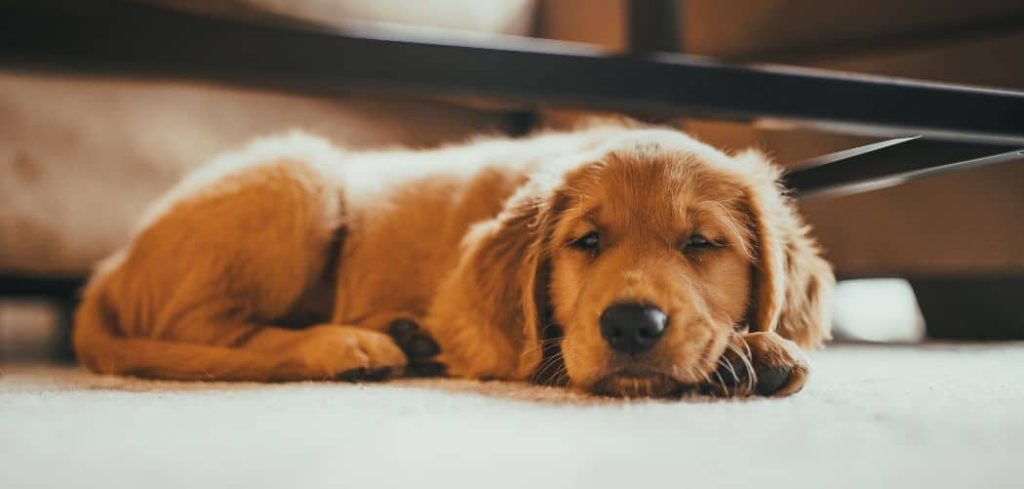Seeing your dog panting heavily after anesthesia can be worrying. While panting can sometimes be part of a normal recovery, it may also signal a complication that needs prompt attention.
We outline the most common causes of a dog panting after anesthesia, what you can do at home, and when to seek veterinary help.
Table of Contents
Dog Panting After Anesthesia — Why It Happens
Dog panting after anesthesia is usually caused by a combination of residual drug effects, pain, stress, and changes in body temperature regulation. Anesthesia drugs can linger in your dog’s system for hours, affecting breathing and temperature control.
Pain from the procedure, anxiety from the unfamiliar environment, and even oxygen level fluctuations during recovery can all contribute.
Some dogs may also be responding to other post-surgical issues like nausea or low blood pressure.

Dog Panting After Anesthesia: Common Causes
Residual Effects of Anesthetic Drugs
Anesthesia affects the central nervous system, and its effects can last beyond the procedure.
These drugs can alter your dog’s ability to regulate body temperature and can cause shallow, rapid breathing.
As the drugs wear off, panting may occur as the body works to restore balance.
Owners may notice that their dog appears groggy, unsteady, and restless in addition to panting.
While mild panting can be normal during this phase, excessive or prolonged panting should not be ignored.
Post-Surgical Pain
Pain is one of the most common reasons a dog pants after anesthesia.
Surgical incisions, tissue handling, and internal discomfort can cause increased respiratory rates.
Panting is a natural canine response to pain, and it may be accompanied by whining, reluctance to move, or guarding the surgical site.
Untreated pain not only delays healing but can also lead to complications like stress-induced high blood pressure. That’s why proper post-operative pain control is essential.
Related: Dog panting excessively (Causes and What To Do)
Anxiety and Stress
Waking up from anesthesia can be a disorienting experience. Strange smells, sounds, and sensations can make a dog anxious. This stress can manifest as panting, pacing, or trembling.
Some dogs, especially those prone to anxiety, may take longer to calm down after surgery.
If panting worsens when you approach or handle them, stress may be playing a major role.
Changes in Body Temperature
Anesthesia can affect how the body regulates temperature. Some dogs may become chilled during surgery, while others may overheat in recovery. Both hypothermia and hyperthermia can cause panting.
Shivering, cold ears, or seeking warmth can indicate low body temperature, whereas warm skin and restlessness may point to overheating.
In both cases, addressing the temperature issue promptly is important.
Oxygen Level Fluctuations
During and after anesthesia, oxygen levels can dip, especially in dogs with preexisting respiratory or cardiac conditions. Panting is one way the body attempts to increase oxygen intake.
Low oxygen levels can cause additional signs like bluish gums, extreme weakness, or collapse. This situation requires immediate veterinary intervention.
Drug Reactions or Complications
Though uncommon, some dogs may react adversely to anesthesia or post-operative medications.
Reactions can range from mild agitation to serious complications like allergic responses or organ stress.
If panting is accompanied by vomiting, diarrhea, hives, or collapse, seek urgent veterinary care.
What to Do If Your Dog Is Panting After Anesthesia
Start by ensuring your dog is in a calm, quiet space at home. A low-stress environment helps reduce anxiety-driven panting.
Keep the room temperature comfortable and avoid overheating or chilling your dog.
Monitor their breathing rate and effort. Occasional mild panting in the first hours post-surgery can be normal, but it should gradually decrease.
Offer fresh water once your vet confirms it’s safe. Follow all medication instructions carefully, especially for pain relief.
If your dog seems restless or uncomfortable, call your vet to discuss adjusting pain management. Avoid handling the surgical site unnecessarily and encourage rest with soft bedding.
When to Call or Visit Your Vet
Contact your vet right away if panting is intense, continuous, or worsening. Labored breathing, blue or pale gums, extreme weakness, or collapse are emergencies.
Also seek help if panting is paired with vomiting, diarrhea, excessive drooling, or signs of pain that aren’t relieved by prescribed medications.
Persistent shivering, extreme lethargy, or confusion can also signal a problem.
Post-anesthetic complications can escalate quickly, so it’s always better to err on the side of caution.
Read more: Dog Panting After Amoxicillin (Here’s why)
Key Takeaway
Panting after anesthesia in dogs can be normal during the initial recovery period, but it should improve over time.
Causes range from residual drug effects and pain to stress, temperature changes, or more serious complications.
Providing a calm recovery space, monitoring symptoms, and following your vet’s aftercare instructions can help your dog recover comfortably.
If in doubt, always reach out to your veterinarian. Prompt attention ensures your dog’s safety and peace of mind for you.
